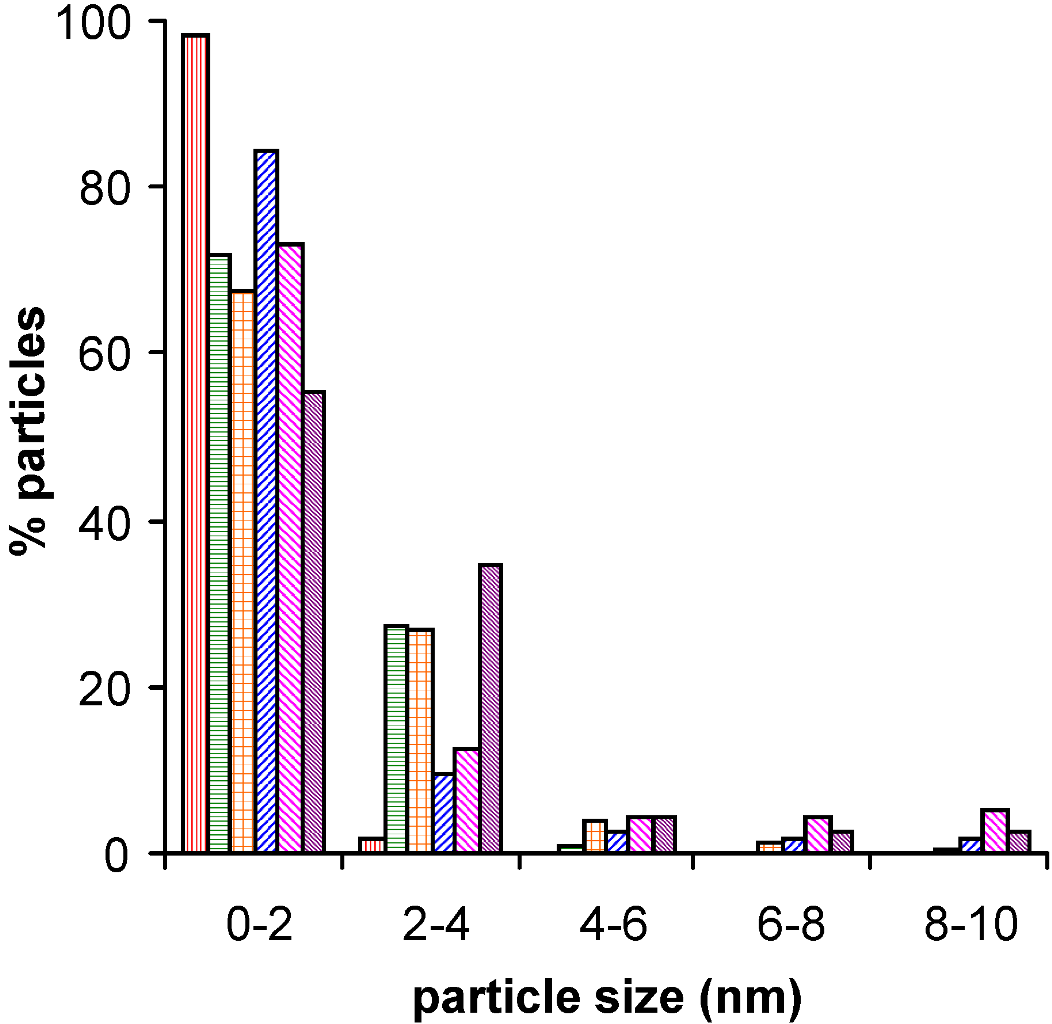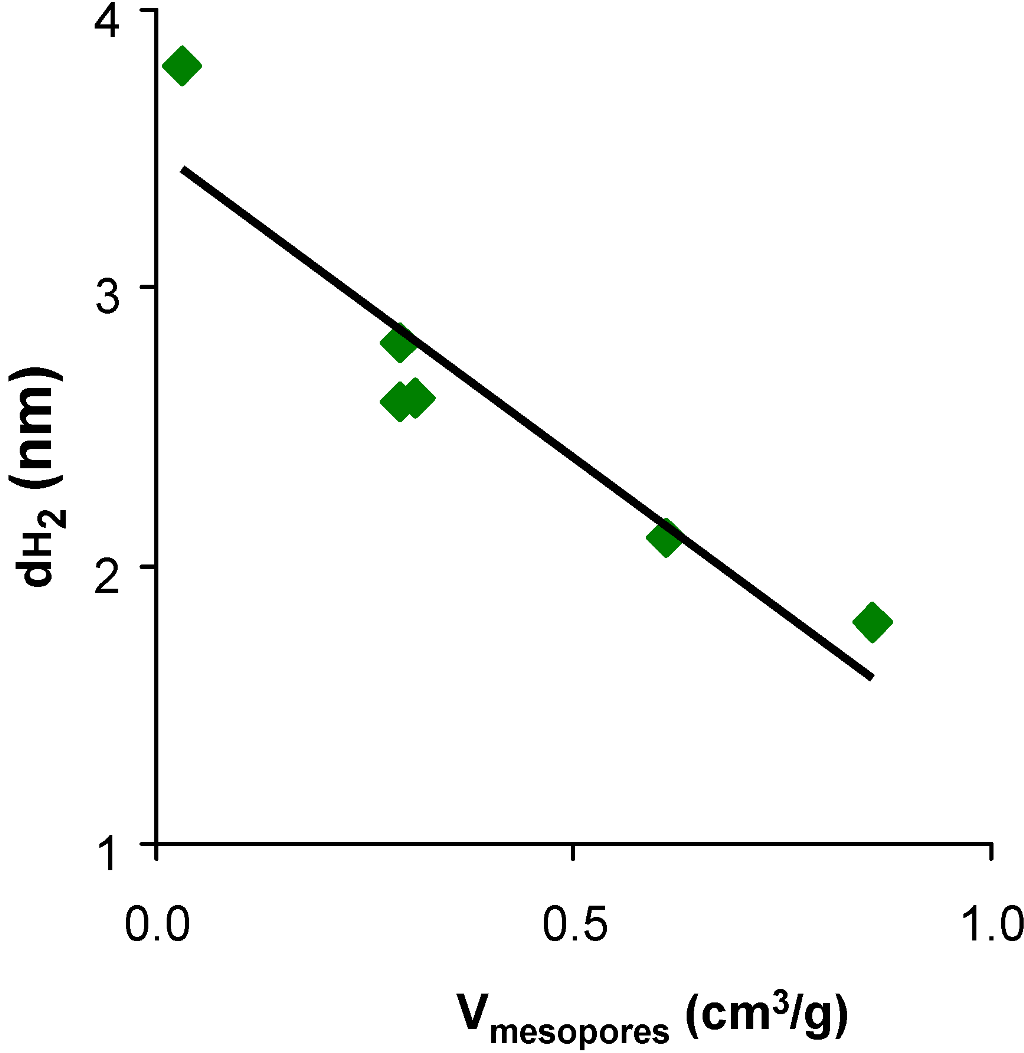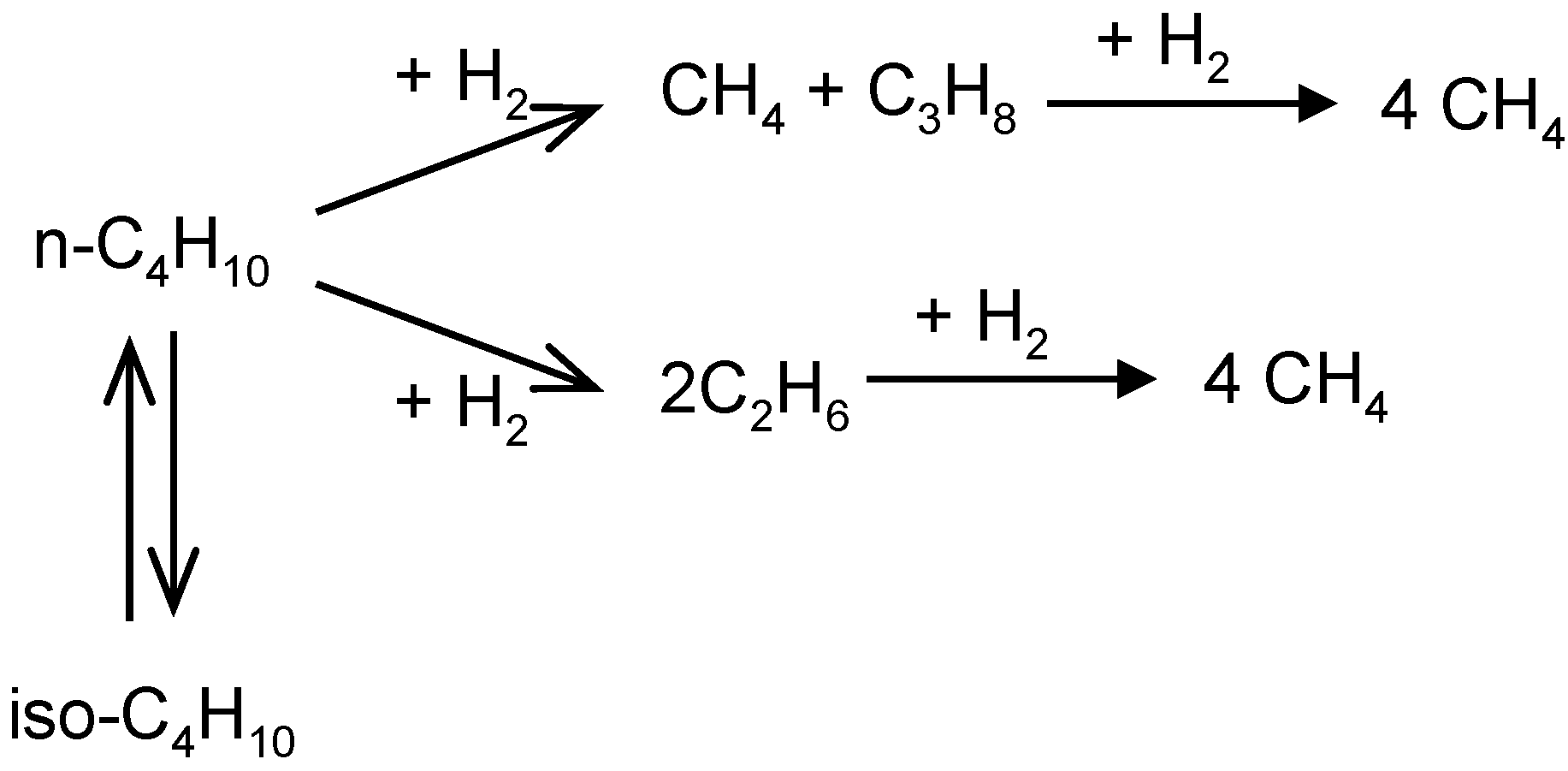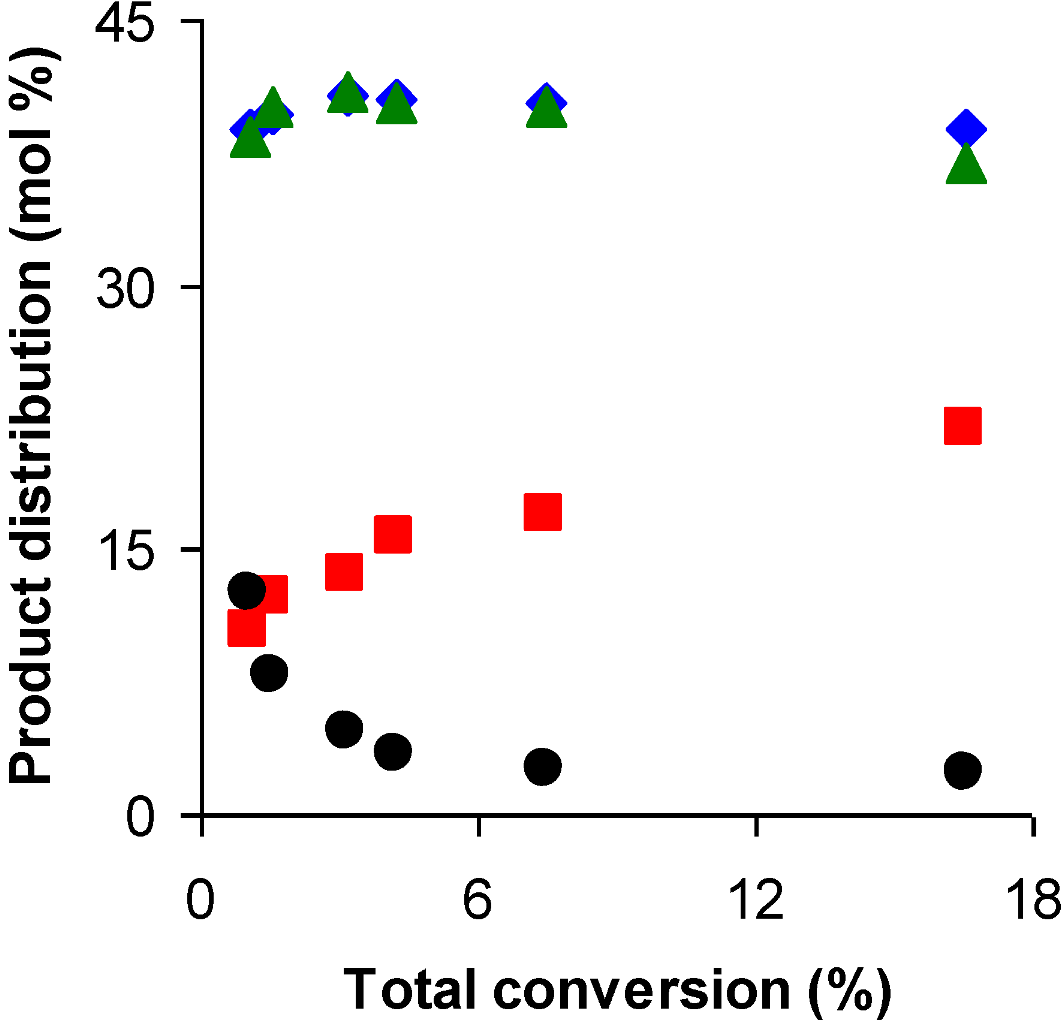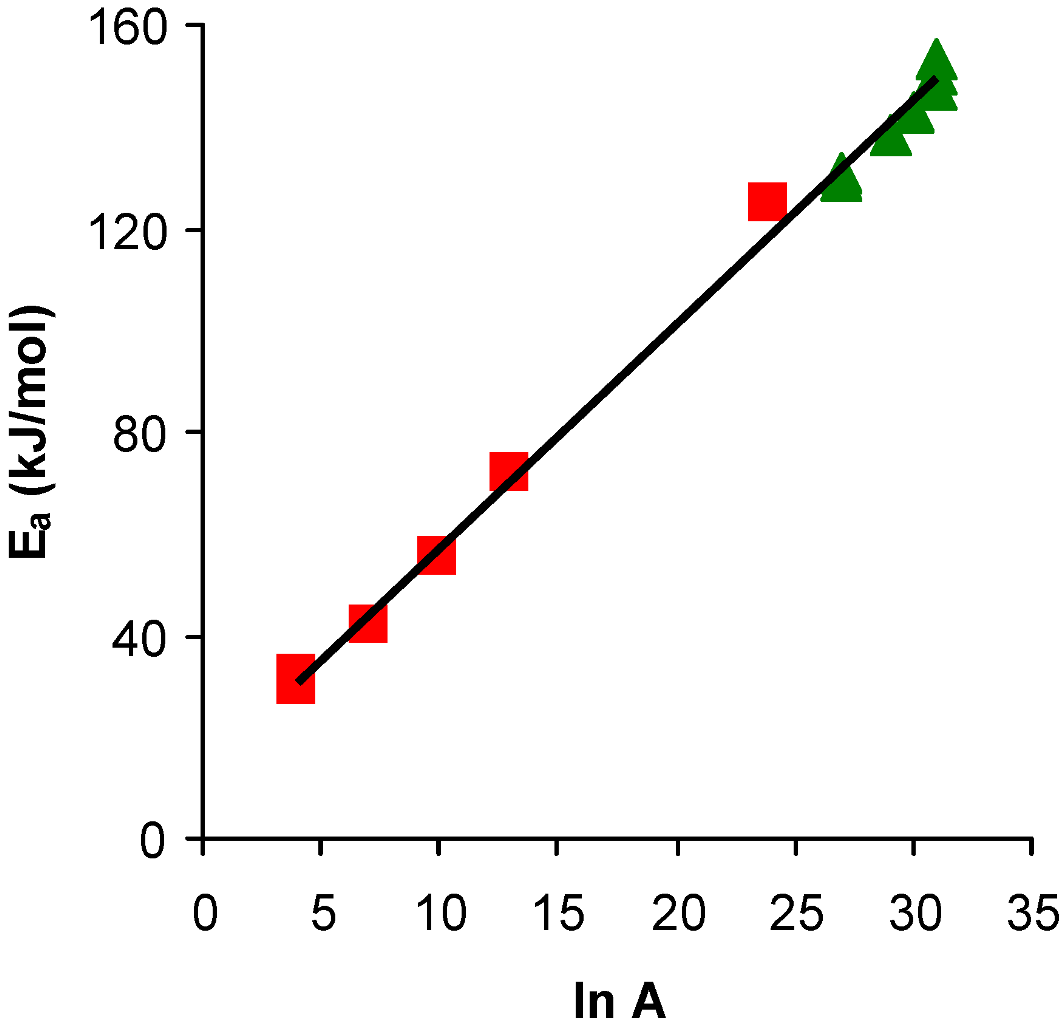1. Introduction
Alkane hydrogenolysis consists of the breakage of C-C bonds with the uptake of hydrogen. It is always exothermic, because each hydrogenolysis reaction involves the rupture of a C-C bond and the formation of two C-H bonds. Alkane hydrogenolysis over supported metal catalysts is of theoretical interest, because many hydrogenolysis reactions are structure sensitive, as well as having industrial applications in alkane reforming [
1,
2,
3].
The type of metal influences the catalyst activity and hydrogenolysis depth, i.e., the number of C-C bonds broken per collision of a reactant molecule with the catalyst surface. For instance, Pt is not as active as other metals in groups 8, 9, and 10 of the Periodic Table, but it is highly selective for single hydrogenolysis, breaking a single C-C bond per collision with the metal surface.
Alkane isomerization can also take place under hydrogenolysis conditions, although Pt catalysts are generally more active in hydrogenolysis than in the isomerization reaction. Both reactions depend on the metal catalyst and support.
Carbon aerogels can be used as supports for metal catalysts among other applications because they can be prepared with high purity and homogeneity, and with controlled micro and mesoporosity [
4]. In addition, carbon aerogels can be synthesized in a large variety of forms such as monoliths, microspheres, powders and thin films. These materials are produced by the carbonization of organic aerogels prepared by the sol-gel polymerization of phenolic compounds with formaldehyde [
5], using either basic or acid catalysts, and dried with supercritical CO
2.
In the present work, carbon aerogels obtained at different carbonization temperatures and with varying mesopore volumes were used as supports for Pt catalysts to study the influence of support characteristics on Pt particle size and activity in the n-C4H10/H2 reaction. An activated carbon was also used as Pt catalyst support for the purposes of comparison.
2. Results and Discussion
Table 1 compiles the surface area,
Vmicropores (Ø < 2 nm) and
Vmesopores (2 < Ø < 50 nm) of the supports. These surface characteristics were discussed in details elsewhere [
6,
7,
8].
Table 1.
Surface area and porosity of the supports.
Table 1.
Surface area and porosity of the supports.
| Supports | SBET (m2/g) | Vmicropores (cm3/g) | Vmesopores (cm3/g) |
|---|
| CA1 | 618 | 0.26 | 0.86 |
| CA2 | 700 | 0.29 | 0.61 |
| CA3 | 592 | 0.26 | 0.03 |
| P3-900 | 588 | 0.23 | 0.30 |
| POX-900 | 519 | 0.23 | 0.31 |
| POX-500 | 514 | 0.21 | 0.29 |
| BV46 | 1153a | 0.40 | n.db |
A TEM micrograph of catalyst P3-900-2Pt after its reduction pre-treatment is given in
Figure 1, as an example, and shows that Pt particles are well dispersed on the support.
Figure 2 depicts the PSDs of catalysts supported on carbon aerogels. Distributions are narrow, with around more than 80% of particles being <4 nm in size.
Figure 1.
TEM picture of catalyst P3-900Pt.
Figure 1.
TEM picture of catalyst P3-900Pt.
Figure 2.
Particle size distribution of catalysts CA1Pt,
![Catalysts 02 00422 i001]()
; CA2Pt,
![Catalysts 02 00422 i002]()
; CA3Pt,
![Catalysts 02 00422 i003]()
; P3-900Pt,
![Catalysts 02 00422 i004]()
; POX-900Pt,
![Catalysts 02 00422 i005]()
; POX-500Pt,
![Catalysts 02 00422 i006]()
.
Figure 2.
Particle size distribution of catalysts CA1Pt,
![Catalysts 02 00422 i001]()
; CA2Pt,
![Catalysts 02 00422 i002]()
; CA3Pt,
![Catalysts 02 00422 i003]()
; P3-900Pt,
![Catalysts 02 00422 i004]()
; POX-900Pt,
![Catalysts 02 00422 i005]()
; POX-500Pt,
![Catalysts 02 00422 i006]()
.
Mean Pt particle size (
d) and its dispersion (
D) from H
2 chemisorption at 25 °C and from TEM are compiled in
Table 2. For the same catalyst,
dH2 and
dTEM values are similar or very close.
Table 2.
Mean particle size (d) and dispersion (D) from H2 chemisorption at 25 °C and TEM, and surface to total Pt ratio (PtXPS/Pttotal).
Table 2.
Mean particle size (d) and dispersion (D) from H2 chemisorption at 25 °C and TEM, and surface to total Pt ratio (PtXPS/Pttotal).
| Catalyst | dH2 (nm) | dTEM (nm) | DH2 (%) | DTEM (%) | PtXPS/Pttotal |
|---|
| CA1Pt | 1.8 | 1.3 | 60 | 83 | 1.0 |
| CA2Pt | 2.1 | 1.6 | 51 | 68 | 0.6 |
| CA3Pt | 3.8 | 2.9 | 28 | 37 | 0.3 |
| P3-900Pt | 2.6 | 2.7 | 42 | 40 | 0.8 |
| POX-900Pt | 2.6 | 2.6 | 42 | 42 | 0.8 |
| POX-500Pt | 2.8 | 2.7 | 39 | 40 | n.d |
| BV46Pt | 4.0 | n.d | 27 | n.d | n.d |
Figure 3 shows that the mean Pt particle size linearly decreases when the mesopore volume of the support increases, indicating the importance of this type of pores to obtain a high Pt dispersion.
Figure 3.
Relationship between mean Pt particle size and mesopore volume of the support.
Figure 3.
Relationship between mean Pt particle size and mesopore volume of the support.
The Pt
4f7/2 core level deconvoluted spectra of catalysts showed two peaks [
6], at binding energies of 71.6 eV and 73.0 eV, which are assigned to Pt(0) and Pt(II), respectively [
6,
9,
10].
Table 2 shows the Pt
XPS/Pt
total ratio, which is equal to the unity for the catalyst with the highest metal dispersion (CA1Pt) and takes the lowest value for the catalyst with the lowest dispersion (CA3Pt). This is due to the decrease in surface Pt atoms
versus total Pt atoms when Pt particle size increases.
The
n-C
4H
10/H
2 reaction catalyzed by Pt yields the hydrogenolysis products (propane, ethane and methane) simultaneously with iso-butane according to the following
Scheme 1:
Scheme 1.
Simultaneous hydrogenolysis and isomerization of n-butane.
Scheme 1.
Simultaneous hydrogenolysis and isomerization of n-butane.
Given that
n-butane has only four carbon atoms, the formation of cyclic isomerization products is unlikely, and the only isomerization product is iso-butane. The reaction is produced in the presence of H
2, which regulates the concentration of surface intermediates with different degrees of dissociation [
1]. Hydrogenolysis of
n-butane can take place through a terminal C-C bond cleavage, yielding CH
4 and C
3H
8, or by a central C-C bond cleavage, yielding C
2H
6. In the first case, the propane produced can undergo hydrogenolysis, yielding ethane and methane, and the ethane produced can be further degraded to methane.
Product distributions obtained at 320 °C are compiled in
Table 3, and
Figure 4 depicts, as an example, the variation of product distributions with total conversion for catalyst POX-900Pt. Results show that the percentages of methane and propane produced are practically the same in all cases. Hence, it can be assumed that the methane obtained in the reaction is produced by terminal C-C bond cleavage and that there is no multiple hydrogenolysis of butane as with other catalysts, e.g., Ni [
3,
11].
Table 3.
Conversion (%) and product distribution (mol%) in the hydrogenolysis (H) and isomerization (I) reactions at 320 °C.
Table 3.
Conversion (%) and product distribution (mol%) in the hydrogenolysis (H) and isomerization (I) reactions at 320 °C.
| Catalyst | Conversion (%) | C1 | C2 | C3 | i-C4 |
|---|
| H | I |
|---|
| CA1Pt | 6.2 | 0.4 | 40 | 17 | 40 | 3 |
| CA2Pt | 6.7 | 0.4 | 40 | 17 | 40 | 3 |
| CA3Pt | 6.0 | 0.7 | 40 | 16 | 39 | 5 |
| P3-900Pt | 7.3 | 0.3 | 41 | 17 | 40 | 2 |
| POX-900Pt | 7.1 | 0.4 | 40 | 17 | 40 | 3 |
| POX-500Pt | 0.3 | 0.3 | 30 | 9 | 30 | 31 |
| BV46Pt | 0.8 | 0.3 | 35 | 18 | 30 | 17 |
Figure 4.
Relationship between product distribution and total conversion for catalyst POX-900Pt. ◆ C1, ■ C2, ▲ C3, ● i-C4.
Figure 4.
Relationship between product distribution and total conversion for catalyst POX-900Pt. ◆ C1, ■ C2, ▲ C3, ● i-C4.
TOF values at 320 °C are compiled in
Table 4. TOF
H is much higher than TOF
I, by around one order of magnitude, for Pt catalysts supported on carbon aerogels obtained at 900–950 °C. These results are in agreement with reports for Pt(100) and Pt(111) single crystals and polycrystalline Pt foil [
12] and for Pt catalysts supported on zeolite [
13]. In contrast, Pt catalysts prepared with support carbonized at 500 °C (POX-500) and the activated carbon BV46 exhibit much lower TOF
H values
versus the other catalysts, which are of the same order of magnitude to TOF
I values.
Table 4.
Turnover frequency (TOF) at 320 °C, apparent activation energy (Ea) and pre-exponential factor (Ln A) for hydrogenolysis (H) and isomerization (I) reactions.
Table 4.
Turnover frequency (TOF) at 320 °C, apparent activation energy (Ea) and pre-exponential factor (Ln A) for hydrogenolysis (H) and isomerization (I) reactions.
| Catalyst | TOFH.103 s−1 | TOFI.103 s−1 | Temp. range °C | Ea(H) kJ/mol | Ln A(H) | Ea(I) kJ/mol | Ln A(I) |
|---|
| CA1Pt | 37.5 | 2.5 | 260–340 | 131 | 27 | 42 | 7 |
| CA2Pt | 51.2 | 3.1 | 270–320 | 138 | 29 | 30 | 4 |
| CA3Pt | 74.3 | 8.2 | 280–320 | 150 | 31 | 55 | 10 |
| P3-900Pt | 67.4 | 3.0 | 280–380 | 143 | 30 | 32 | 4 |
| POX-900Pt | 61.6 | 3.3 | 280–350 | 147 | 31 | 31 | 4 |
| POX-500Pt | 3.2 | 3.1 | 280–390 | 153 | 31 | 72 | 13 |
| BV46Pt | 8.1 | 2.6 | 300–400 | 129 | 27 | 125 | 24 |
Importantly, the TOF
H of POX-500Pt is around 20-fold lower than that of POX-900Pt, despite the similar surface area and pore texture of the supports (
Table 1) and the similar mean Pt particle size of the catalysts (
Table 2). A major difference between the carbon aerogels carbonized at 500 and 900 °C was the greater degree of aromatization of the carbon structure in the latter. Thus, the full width at the half maximum of the C
1s graphite XP peak at 284.6 eV decreases at the heat treatment increases from 500 to 1500 °C due to the loss of oxygen atoms and to a certain ordering of the aromatic structure of the graphene layers of the carbon aerogel [
7].
According to this finding, the higher the aromatization degree of the carbon aerogel, the higher is the TOF
H of supported Pt catalyst. One explanation may be an electronic transfer between the support and Pt particles that would facilitate the cracking of the chemisorbed alkane (see below). A further possible explanation for the difference in TOF
H and TOF
I values is that Pt particles supported on carbon aerogels obtained at 900–950 °C develop preferentially low-index Pt surfaces. Thus, it has been shown [
12] that the more open Pt(100) surfaces are more active for the hydrogenolysis of
n-butane than the close-packed Pt(111) surfaces, by one order of magnitude.
The TOF
H and TOF
I values of catalyst BV46Pt are of the same order of magnitude as published findings for other Pt catalysts supported on activated carbons [
1]. The difference in aromatization degree between carbon aerogels obtained at high temperature and activated carbons may also account for this behavior.
The relationships of TOF
H and TOF
I with mean Pt particle size are depicted in
Figure 5 for catalysts supported on carbon aerogels prepared at 900–950 °C. TOF
H shows a large increase with d
H2 up to around 2.7 nm in size, being more moderate this increase for higher sizes up to around 4 nm. However, TOF
I shows a linear increase throughout the studied d
H2 range although less markedly in comparison to TOF
H. Hydrogenolysis in the above catalysts appears to be sensitive to the catalyst structure, at least up to a mean Pt particle size of 2.7 nm. However, TOF
I showed a lesser variation in the studied particle size range, and the sensitivity of this reaction to the catalyst structure is less clear. These results differ from findings for Pt catalysts supported on activated carbons [
1], which showed that TOF
H linearly increased with smaller mean Pt particle size and that TOF
I was not sensitive to variations in Pt particle size within the range studied (2.1–13.5 nm). This could be attributable to the above commented differences in surface chemistry between carbon aerogels and activated carbons.
Figure 5.
Relationship of TOFH, closed symbols and TOFI, open symbols at 320 °C with the mean Pt particle size for catalysts supported on carbon aerogels obtained at 900 °C, ● and 950 °C, ▲.
Figure 5.
Relationship of TOFH, closed symbols and TOFI, open symbols at 320 °C with the mean Pt particle size for catalysts supported on carbon aerogels obtained at 900 °C, ● and 950 °C, ▲.
Arrhenius plots were used to calculate the apparent activation energy for hydrogenolysis
Ea(H) and isomerization
Ea(I) and the corresponding pre-exponential factors (Ln A).
Figure 6 shows a typical example of such plots for catalyst POX-900Pt. The numbers for the experimental points indicate the order in which they were determined and there is a good agreement for data obtained in increasing and decreasing temperature cycles. This is a good indication of the fact that in the experimental procedure followed the Pt surface is clean in each activity measurement and that there is no deactivation of the catalyst.
Figure 6.
Arrhenius plot for catalyst POX-900Pt: □, hydrogenolysis;∆, isomerization.
Figure 6.
Arrhenius plot for catalyst POX-900Pt: □, hydrogenolysis;∆, isomerization.
Table 4 shows the apparent activation energies and corresponding pre-exponential factors obtained in the temperature range indicated in that Table.
Ea(H) was higher than
Ea(I) for all catalysts supported on carbon aerogels, whereas both activation energies were equal for catalyst BV46Pt in agreement with findings for Pt catalysts supported on activated carbons [
1].
Several models have been proposed for hydrogenolysis reactions over metal catalysts [
3], but the following general reaction mechanism, that would also explain the isomerization, is widely accepted.
Step 1. Dissociative dihydrogen chemisorption and dehydrogenative chemisorption of the alkane.
where Pt
s is a surface Pt atom. The formation of this 1,3 diasorbed dehydrogenated alkane intermediate has been postulated for the hydrogenolysis of saturated hydrocarbons on Pt [
1].
Steps 2 and 3. Fragmentation and rearrangement of the dehydrogenated species, and rehydrogenation and desorption of the product.
The plot of
Ea against Ln A for both the hydrogenolysis and isomerization reactions and for all catalysts is shown in
Figure 7, and indicates a good compensation effect (correlation coefficient,
R2 = 0.997). This compensation effect has been observed for alkane hydrogenolysis over Pt catalysts [
2,
3] and other metals [
14] and in other systems [
15,
16]. An interesting observation is that the isomerization reaction lies on the same compensation effect plot as the hydrogenolysis reaction. This means that both reactions have a common intermediate,
i.e., the dehydrogenated alkane formed in
Step 1. Thus, rearrangement of the η
2-propene intermediate in
Step 2 could yield isobutane.
The above hydrogenolysis mechanism may also explain the higher TOFH value of Pt catalysts supported on carbon aerogels obtained at 900–950 °C in comparison to those obtained at 500 °C. The π-olefin complexes in Step 2 are formed by a dative π-bond from the hydrocarbon to empty d-orbitals of Pt and a retrodonating π-bond from the filled d-orbitals to the empty π* antibonding orbital of the olefin, and the two bonds reinforce each other by a synergic mechanism. Therefore, an increase in the aromatization degree of the support would increase the electronic density on the supported Pt particles, leading to an increase of the retrodonating π-bond, and making easier the formation of the above π-olefin complexes, and therefore, the cracking of the chemisorbed dehydrogenated n-butane.
Figure 7.
Relationship between Ea and Ln A for the hydrogenolysis (▲) and isomerization (∎) of n-butane.
Figure 7.
Relationship between Ea and Ln A for the hydrogenolysis (▲) and isomerization (∎) of n-butane.
3. Experimental Section
Supports used were the carbon aerogels CA1, CA2, CA3, P3-900, POX-500, and POX-900.
Table 5 compiles the ingredients used in the preparation of the organic hydrogels.
Table 5.
Organic aerogel recipes (Formaldehyde, 0.224 mol).
Table 5.
Organic aerogel recipes (Formaldehyde, 0.224 mol).
| Sample | Resorcinol (mol) | Pyrocatechol (mol) | Catalyst precursor (mol) | Solvent (mL) |
|---|
| CA1 | 0.112 | - | 1.4 × 10−4 K2CO3 | H2O (27) |
| CA2 | 0.112 | - | 1.4 × 10−4 K2CO3 | H2O-MeOH a (24-3) |
| CA3 | 0.112 | - | 1.4 × 10−4 K2CO3 | H2O-THF a (24-3) |
| P3 | - | 0.112 | 2.1 × 10−2 H3BO3 | H2O (26.7) |
| POX | - | 0.112 | 2.0 × 10−4 H2C2O4 | H2O (26.7) |
Subsequently, they were dried with supercritical CO
2 and carbonized in N
2 flow at 500 °C (POX-500), 900 °C (P3-900 and POX-900) and 950 °C (CA1, CA2 and CA3). Details of the preparation of all these samples were previously reported [
6,
7]. The activated carbon BV46 was also used as support. This sample was prepared from olive stones after carbonization in N
2 flow at 900 °C and steam activation at 850 °C to 46% burn-off [
8]. Characterization of the supports was carried out by N
2 adsorption at −196 °C, mercury porosimetry and immersion calorimetry into benzene at 30 °C.
Supported Pt catalysts were prepared by impregnation of the supports with an aqueous solution of [Pt(NH
3)
4]Cl
2 to yield Pt catalysts with a metal loading of 2 wt.%, referred to by adding Pt to the name of the carbon aerogel. Exact total Pt content (Pt
tot) of supported catalysts was obtained by burning them off at 800 °C in air and weighing the residue. The supported catalysts were pre-treated in He flow, 60 cm
3/min, at 400 °C for 12 h before their characterization by H
2 chemisorption, transmission electron microscopy (TEM) or X-ray photoelectron spectroscopy (XPS) as explained in detail elsewhere [
6]. Platinum dispersion,
D, and its average particle size,
d, were obtained from the H
2 uptake, assuming that one H atom was chemisorbed by one surface Pt atom and that
dH2(nm)=1.08/
D. Particle size distributions (PSDs) were obtained analyzing different TEM micrographs from which the dispersion and average particle size were also calculated.
The
n-C
4H
10/H
2 reaction was studied in a glass plug-flow microreactor, using 1 g of catalyst at a temperature between 260 and 390 °C depending on the supported catalyst in question, and following the experimental procedure described in reference [
1]. Before the reaction, catalysts were pre-treated in the same reactor at 400 °C in He flow for 12 h. Subsequently, samples were cooled in He flow at the reaction temperature and the He flow was switched to an
n-C
4H
10/H
2 flow, 60 cm
3/min, with a 1/10 molar ratio. Gases from the reactor were analyzed on-line by using a Varian model CP-3800 gas chromatograph with a Chromosorb 102 column. To reach steady-state conditions in the reactor, the reactant gases were flowed through the catalysts for 20 min before analyzing the reaction products; after the analysis only H
2 was flowed through the catalysts for 20 min in order to regenerate and clean the Pt surface; after this proces the C
4H
10/H
2 mixture was again introduced into the reactor in order to study the reaction at different temperatures. The reactor was operated at atmospheric pressure, and the conversion was kept below around 16%.
Catalytic activity measurements for hydrogenolysis and isomerization are reported as the TOF, defined as the number of molecules reacting per surface metal atom per second, and calculated from Equation (1):
where TOFx is the turnover frequency for hydrogenolysis (TOFH) or isomerization (TOFI) in s−1; Px is the proportion of n-butane undergoing hydrogenolysis (PH) or converted to isobutane (PI); Fn-C4H10 is the n-butane flow rate (cm3/min); W is the weight of catalyst (g); QH2 is the dihydrogen uptake (μmol/g), multiplied by two because dihydrogen is dissociatively chemisorbed on two surface Pt atoms; and 0.74 is the conversion factor (cm3/min to μmol/s).
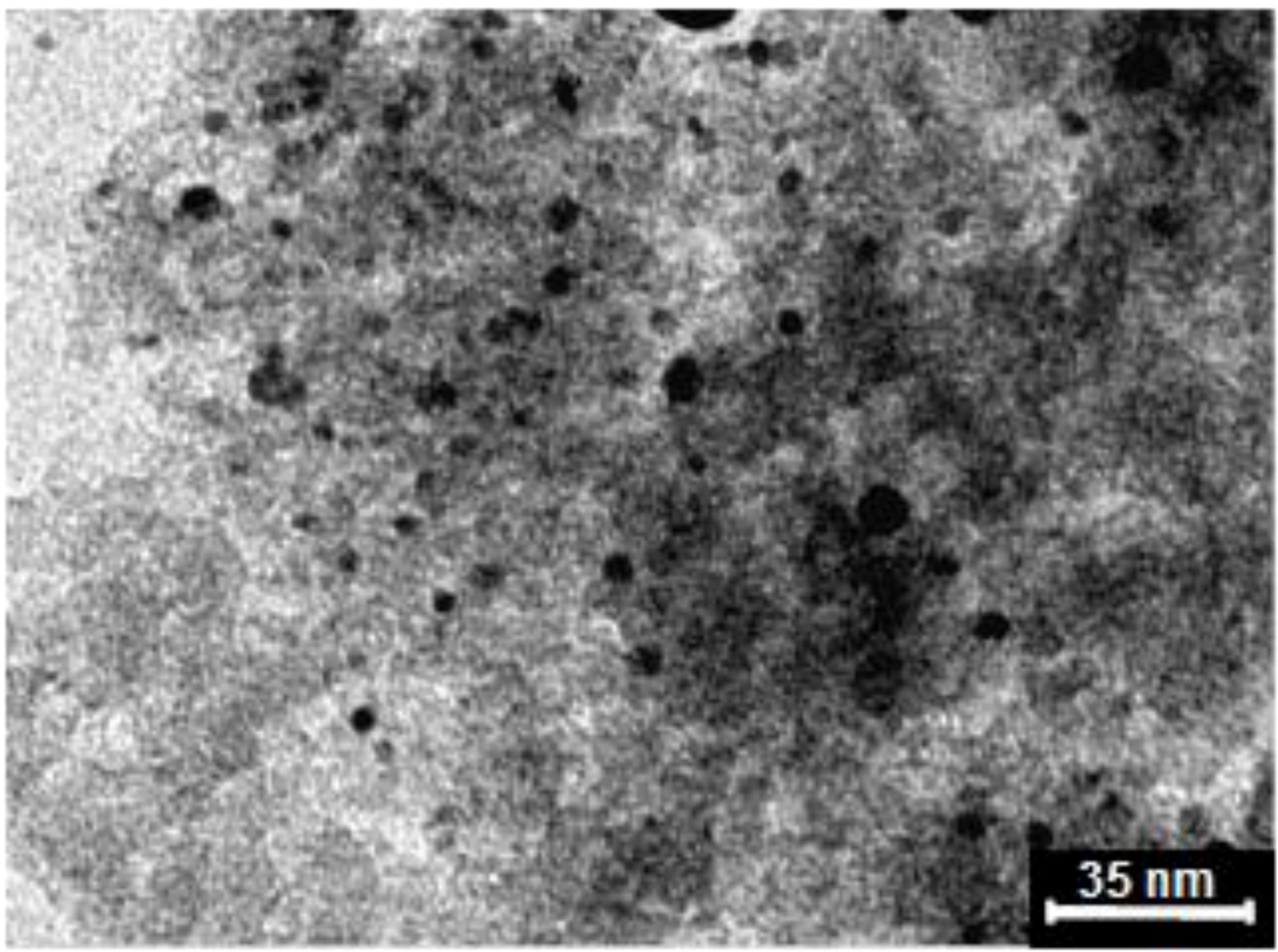
 ; CA2Pt,
; CA2Pt,  ; CA3Pt,
; CA3Pt,  ; P3-900Pt,
; P3-900Pt,  ; POX-900Pt,
; POX-900Pt,  ; POX-500Pt,
; POX-500Pt,  .
.
 ; CA2Pt,
; CA2Pt,  ; CA3Pt,
; CA3Pt,  ; P3-900Pt,
; P3-900Pt,  ; POX-900Pt,
; POX-900Pt,  ; POX-500Pt,
; POX-500Pt,  .
.